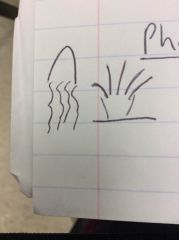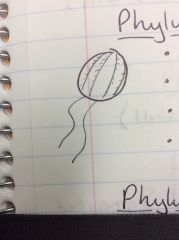![]()
![]()
![]()
Use LEFT and RIGHT arrow keys to navigate between flashcards;
Use UP and DOWN arrow keys to flip the card;
H to show hint;
A reads text to speech;
66 Cards in this Set
- Front
- Back
|
Features of Kingdom Animalia
|
Sexual reproduction
Heterotrophic Multicellular Eukaryotes Mobility Adult is diploid |
|
|
Parazoa
|
Category of Kingdom Animalia. No true tissues, organs, or organ systems. Contains Phylum Porifera (sponges).
|
|
|
Eumatazoa
|
Category of Kingdom Animalia. Has true tissues. Contains Radiata and Bilateria.
|
|
|
Radiata
|
A category of Eumetazoa. Has radial or biradial symmetry. Includes Phylum Cnidaria (jellyfish) and phylum Ctenophora (combjellies).
|
|
|
Phylum Cnidaria
|

A category of Radiata. Has radial symmetry. Includes Jellyfish, anemones, hydra, coral. Two types: Medusa and Polyp.
|
|
|
Phylum Ctenophora
|

A category of Radiata. Has biradial symmetry. Includes Combjellies. Have 8 rows of cilia around the body. Are bioluminescent. Have adhesive cells instead of stinging cells.
|
|
|
Bilateria
|
A category of Eumetazoa. Has bilateral symmetry. Includes Protostomia and Deuterostomia.
|
|
|
Protostomia
|
A category of Bilateria. Has spiral, determinate cleavage. The blastopore becomes the mouth.
|
|
|
Deuterostomia
|
A category of Bilateria. Has radial, indeterminate cleavage. The blastopore becomes the anus. Includes Phyla Echinodermata, Hemichordata, and Chordata.
|
|
|
Phylum Platyhelminthes
|
A Protostomia . Tapeworms, flukes, and planarians.
|
|
|
Phylum Nemertea
|
A Protostomia. Ribbon worms. Extremely thin and long. Found in whales and other marine animals. Have a proboscis.
|
|
|
Phylum Mollusca
|
A Protostomia. Mollusks, oysters, clams, squid. Soft bodies with Head, Visceral Mass, and Mantle. Have a Radula.
|
|
|
Phylum Annelida
|
A Protostomia. Earthworms, segmented worms. Have a complete digestive tract and Setae.
|
|
|
Phylum Rotifera
|
A Protostomia. "Wheel animals." Have a row of cilia around the mouth. Can "freeze" themselves for long periods of time.
|
|
|
Phylum Nematoda
|
A Protostomia. Round worms, heart worms, and hook worms. Tend to be parasitic. Have a complete digestive system and well-developed organs.
|
|
|
Phylum Tardigrada
|
A Protostomia. Water bears. Three pair of branched, clawed legs. Can freeze themselves for long erupts of time.
|
|
|
Phylum Onychophora
|
A Protostomia. Velvet worms. Segmented bodies made of Chitin.
|
|
|
Phylum Arthropoda
|
The largest group of Protostomia. Insects, spiders, mites, crabs, ticks, lobsters. 78% of all animals are in this group.
|
|
|
Phylum Echinoderma
|
A Deuterostomia. Starfish, sand dollars, sea urchins. Have a water vascular system with tubed feet. Have endoskeleton projections. Can regrow legs.
|
|
|
Phylum Hemichordata
|
A Deuterostomia. Acorn worms. Have a proboscis, collar, and trunk.
|
|
|
Phylum Chordata
|
A Deuterostomia. Includes humans.
|
|
|
Acoelomates
|
A group of Bilateria. Have no body cavity. Includes Phyla Platyhelminthes and Nemertea.
|
|
|
Pseudocoelomates
|
A group of Bilateria. Have a "false" body cavity not completely lined with mesoderm. Includes Phyla Nematoda and Rotifera.
|
|
|
Coelomates
|
A group of Bilateria. Have a true body cavity completely lined with mesoderm.
|
|
|
Phylum Porifera
|
Sponges. Parazoa. Have no true tissues, jus masses of cells. Filter feeders. Contain many pores. Contain collar cells, microvilli, flagellum. All aquatic. Reproduce externally.
|
|
|
Cnidocyte
|
Special stinger found only in Phylum Cnidaria. Contains a nematocyst.
|
|
|
Tapeworm Process
|
1)Cow eats infected grass. 2)Larva move to muscle tissue, form cysts. 3)Human eats undercooked meat. 4)larva hatches from cyst, moves to intestine. 5)larva grows. 6)gravid proglotids pass with feces.
|
|
|
Proglotids
|
Reproductive mechanism of tapeworms. Contain both male and female reproductive parts.
|
|
|
Proboscis
|
A long, retractable probe found in Phylum Nemertea. Injects venom into prey.
|
|
|
Radula
|
Rasping tongue found in Phylum Mollusca.
|
|
|
Setae
|
Bristles for moving through soil. Found in Phylum Annelida.
|
|
|
Characteristics of Phylum Chordata
|
Notochord,
Dorsal nerve chord, Pharyngeal gill slits, Post-anal tail |
|
|
Sub Phylum Urochordata
|
Retain none of the Chordata characteristics as adults.
|
|
|
Sub Phylum Urochordata
|
Retain none of the Chordata characteristics as adults.
|
|
|
Sub Phylum Cephalachordata
|
Lancelets. Retain all characteristics of Chordata as adults.
|
|
|
Sub Phylum Urochordata
|
Retain none of the Chordata characteristics as adults.
|
|
|
Sub Phylum Cephalachordata
|
Lancelets. Retain all characteristics of Chordata as adults.
|
|
|
Sub Phylum Vertebrata
|
Vertebral column
Endoskeleton Neural Crest Well-defined head Well-developed organs |
|
|
Class Mixini
|
Hagfish. No vertebrae. Eel like. No jaw. Secrete slime.
|
|
|
Class Mixini
|
Hagfish. No vertebrae. Eel like. No jaw. Secrete slime.
|
|
|
Class Cephalaspidomorphi
|
Lamprey. Scavengers and predators. Similar to Mixini.
|
|
|
Class Mixini
|
Hagfish. No vertebrae. Eel like. No jaw. Secrete slime.
|
|
|
Class Cephalaspidomorphi
|
Lamprey. Scavengers and predators. Similar to Mixini.
|
|
|
Class Chondrichthyes
|
Sharks, skates, and rays. Heterocercal tail. Streamlined body. Lateral line system sensitive to vibration. Noses detect blood and electricity.
|
|
|
Class Actinopterygii
|
Ray finned fishes. Bony Rays in the fins. Skeleton is made of bone.
|
|
|
Class Actinopterygii
|
Ray finned fishes. Bony Rays in the fins. Skeleton is made of bone.
|
|
|
Class Sarcopterygii
|
Lobe-finned fishes. Muscular fins, possibly the beginnings of terrestrial legs.
|
|
|
Class Dipnoi
|
Lung fish. Typically found in the Southern Hemisphere. Capable of moving on dry land for short periods of time.
|
|
|
Class Amphibia
|
Truly terrestrial limbs. 3-chambered heart. Have lungs. Moist skin. Ectothermic. Many are brightly colored and/or poisonous. Reproduce aquatically.
|
|
|
Class Reptilia
|
Amniotic egg
Ectothermic 3-chambered heart Scaly skin |
|
|
Class Reptilia
|
Amniotic egg
Ectothermic 3-chambered heart Scaly skin |
|
|
Order Squamata
|
An order of class Reptilia. Mostly terrestrial. Legs set at right angles. Snakes have Jacobson's Organ, heat sensing pits, remnant of a femur (called a spur).
|
|
|
Class Reptilia
|
Amniotic egg
Ectothermic 3-chambered heart Scaly skin |
|
|
Order Squamata
|
An order of class Reptilia. Mostly terrestrial. Legs set at right angles. Snakes have Jacobson's Organ, heat sensing pits, remnant of a femur (called a spur).
|
|
|
Order Rhynocephalia
|
An order of class Reptilia. Tuatara. Looks like a lizard. Has a third eye.
|
|
|
Order Chelonia
|
An order of class Reptilia. Turtles and tortoises. Vertebrae are fused to the shell.
|
|
|
Order Crocodylia
|
An order of class Reptilia. Crocodiles, alligators, and caymans. 4-chambered heart allows increased endurance.
|
|
|
Order Crocodylia
|
An order of class Reptilia. Crocodiles, alligators, and caymans. 4-chambered heart allows increased endurance.
|
|
|
Order Ornithiscia
|
An order of class Reptilia. Extinct. Stegosaur. Pelvis faces backward like a bird.
|
|
|
Order Crocodylia
|
An order of class Reptilia. Crocodiles, alligators, and caymans. 4-chambered heart allows increased endurance.
|
|
|
Order Ornithiscia
|
An order of class Reptilia. Extinct. Stegosaur. Pelvis faces backward like a bird.
|
|
|
Order Saurischia
|
An order of class Reptilia. Extinct. T-Rex. 1 pelvic bone faces forward, the other backward. Birds descended from this group.
|
|
|
Order Pterosauria
|
An order of class Reptilia. Extinct. Pterosaurs. Flying reptiles.
|
|
|
Order Pterosauria
|
An order of class Reptilia. Extinct. Pterosaurs. Flying reptiles.
|
|
|
Order Icthyosauria
|
An order of class Reptilia. Extinct. Shark-like.
|
|
|
Order Pleisosauria
|
An order of class Reptilia. Extinct. Large aquatic reptiles (think: Loch Ness monster)
|

